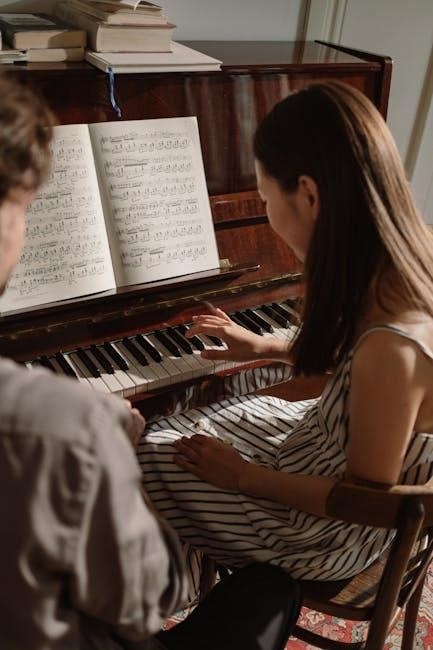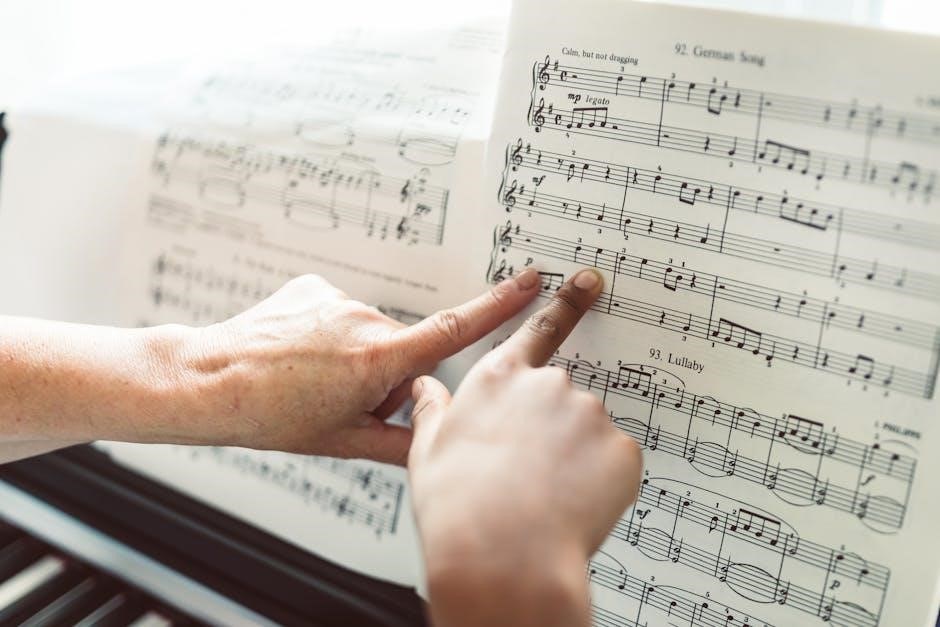The Piano Lesson, a Pulitzer Prize-winning play by August Wilson, explores themes of family legacy, cultural heritage, and identity through the story of a historic piano. Set in 1936 Pittsburgh, the play delves into the emotional and historical significance of the piano, which serves as a symbol of the Charles family’s past. The conflict between selling the piano for land and preserving it as a cultural artifact drives the narrative, highlighting the tension between progress and heritage. This play is a powerful exploration of African-American experiences and identity, making it a cornerstone of Wilson’s renowned Pittsburgh Cycle.
Setting of the Play
The Piano Lesson is set in Pittsburgh’s Hill District during the Great Depression, specifically in the home of Doaker Charles. The action unfolds in the kitchen and parlor, where the family’s ancestral piano dominates the space, symbolizing their history and cultural identity.
2.1. Historical Context: The Great Depression and Pittsburgh
The play is set in 1936 Pittsburgh, during the height of the Great Depression, a period of economic hardship that disproportionately affected African-Americans. Pittsburgh’s Hill District, where the story unfolds, was a vibrant African-American community struggling with poverty and racial inequality. The Great Depression exacerbated these challenges, leaving many families without stable income or resources. The Charles family, like many others, faced economic struggles while clinging to their cultural heritage. The play highlights the resilience of African-Americans during this era, emphasizing the importance of family, history, and cultural identity in the face of adversity. This historical context underscores the themes of survival and heritage that resonate throughout the play.

Characters and Their Roles
Boy Willie, Berniece, and Doaker are central figures in the play, each representing different perspectives on family legacy and cultural identity. Their roles drive the emotional conflict surrounding the piano, a symbol of their shared history. Other characters, like Avery and Maretha, add depth to the narrative, exploring themes of heritage and resilience.
3.1. Major Characters: Boy Willie, Berniece, Doaker, and Others
The play revolves around Boy Willie, a determined and passionate nephew who seeks to sell the family piano to buy land, symbolizing his desire for economic freedom. His sister, Berniece, fiercely opposes this plan, viewing the piano as a cherished family heirloom and a connection to their ancestors. Doaker, their uncle and the household’s caretaker, serves as a voice of reason, offering wisdom and historical context. Other key characters include Maretha, Berniece’s young daughter, who embodies the future of the family legacy, and Avery, a local preacher whose practicality contrasts with the spiritual undertones of the piano. Collectively, these characters explore themes of identity, heritage, and the weight of history.

The Piano as a Symbol
In The Piano Lesson, the piano symbolizes the Charles family’s heritage and history, decorated with African totems. It embodies their resilience and cultural identity, linking past struggles to present conflicts over its fate.
4.1. The Piano’s Historical and Cultural Significance
The piano in The Piano Lesson is a 137-year-old heirloom adorned with African totems, symbolizing the Charles family’s enslaved ancestors and their cultural legacy. Carved by the family’s ancestors, it tells their story of survival and resistance. The piano represents the family’s history, with each carving serving as a visual narrative of their experiences. It is a tangible connection to their African roots and the struggles of their past. The piano transcends its role as a musical instrument, becoming a sacred artifact that embodies the family’s identity and heritage. Its presence evokes both pride and pain, reflecting the complex relationship between the characters and their history. The piano’s significance is deeply intertwined with themes of memory, identity, and the African-American experience.
Themes Explored in the Play
The Piano Lesson explores themes of family legacy, cultural identity, and the clash between preserving heritage and seeking economic progress. The play delves into the emotional and historical significance of the piano, symbolizing the tension between holding onto the past and embracing the future. Through its characters, the play examines the struggles of African-Americans during the Great Depression, highlighting the importance of cultural preservation and the weight of history. These themes resonate deeply, making the play a powerful exploration of identity, family, and resilience.
5.1. Family Legacy and Heritage
The Piano Lesson deeply explores the theme of family legacy and heritage through the iconic piano, which serves as a tangible connection to the Charles family’s past. The piano, adorned with ancestral carvings, symbolizes the family’s history, including their enslaved ancestors and their resilience. It represents a legacy of strength and survival, passed down through generations. However, this legacy becomes a source of conflict, as characters like Boy Willie and Berniece disagree on its value. While Boy Willie sees the piano as a means to achieve economic freedom, Berniece views it as a sacred family heirloom that must be preserved. This tension highlights the struggle between honoring the past and embracing the future, making the piano a powerful symbol of both unity and division within the family. The play underscores the idea that legacy is both a burden and a source of pride, shaping identities and influencing decisions.
5.2. African-American Heritage and Identity
The Piano Lesson is a profound exploration of African-American heritage and identity, using the piano as a symbol of cultural and historical significance. The piano’s intricate carvings, created by the family’s enslaved ancestors, tell the story of their history, struggles, and resilience. It serves as a visual and emotional connection to the past, preserving the memories of those who endured slavery and fought for freedom. The play highlights the importance of African-American heritage in shaping individual and collective identity, emphasizing the need to honor and understand one’s roots. Through the piano, August Wilson illustrates the tension between preserving cultural traditions and embracing a future marked by change and progress. This duality reflects the broader African-American experience, where heritage is both a source of pride and a reminder of the ongoing struggle for equality and recognition.

Cultural and Historical Context
The Piano Lesson is set in 1936 Pittsburgh during the Great Depression, a time of economic hardship and racial tension. The play reflects the African-American experience, using the piano to symbolize cultural heritage and resilience.
6.1. The Great Depression’s Impact on African-Americans
The Great Depression exacerbated economic and social challenges for African-Americans, deepening racial disparities and limiting opportunities. In The Piano Lesson, this backdrop underscores the struggle for financial stability and cultural preservation. The play highlights how African-Americans navigated poverty, discrimination, and the erosion of their heritage. The Depression’s economic hardships are reflected in characters like Boy Willie, who sees land ownership as a path to freedom, and Berniece, who clings to the piano as a symbol of their ancestors’ resilience. The play underscores how African-Americans relied on cultural artifacts to maintain their identity amidst systemic oppression. Wilson’s portrayal of this era emphasizes the intersection of economic struggle and the fight to preserve cultural legacy.

August Wilson’s Legacy
August Wilson is celebrated as one of America’s most influential playwrights, known for his profound portrayal of African-American life. His works, like The Piano Lesson, have earned critical acclaim for their deep exploration of cultural identity and historical heritage, solidifying his legacy as a master storyteller in American theater.
7.1. The Play’s Place in Wilson’s Body of Work
The Piano Lesson holds a significant position in August Wilson’s body of work, being the fourth play in his Pittsburgh Cycle, a series of ten plays exploring the African-American experience across the 20th century. This Pulitzer Prize-winning play is a cornerstone of Wilson’s work, showcasing his ability to weave historical and cultural narratives into compelling drama. It reflects his broader themes of family legacy, identity, and the tension between preserving heritage and embracing progress. Through its exploration of the Charles family’s history, the play exemplifies Wilson’s commitment to highlighting the richness and complexity of African-American life, solidifying his reputation as a master playwright and a vital voice in American theater.
Adaptations and Interpretations
The Piano Lesson has been adapted into films and stage productions, with notable versions directed by prominent figures, ensuring its reach and impact across different audiences and mediums.
8.1. Film Adaptations and Their Reception
The Piano Lesson has been adapted into films, with notable versions showcasing its emotional depth and cultural significance. A recent adaptation, directed by Malcolm Washington, marks a milestone in bringing August Wilson’s work to the screen. The film premiered at the Toronto International Film Festival and received acclaim for its faithful portrayal of the play’s themes. Audiences praised the cast, including Denzel Washington and Danielle Deadwyler, for their powerful performances. Critics highlighted the film’s ability to preserve the play’s essence while offering a fresh cinematic experience. The adaptation underscores the enduring relevance of Wilson’s storytelling and its universal appeal, ensuring the play’s legacy continues to resonate with new generations.

Accessing the Play in PDF Format
The Piano Lesson is widely available in PDF format through platforms like Google Drive, Scribd, and educational websites, offering easy access for readers and scholars worldwide.
9.1. Availability and Sources for the PDF Version
The PDF version of The Piano Lesson is accessible through various online platforms. Platforms like Google Drive and Scribd offer free downloads of the play, with some versions available as early as 2017. Educational institutions and websites also provide access to the PDF for academic purposes. For instance, the PDF titled the-piano-lesson-august-wilson.pdf (11,958 KB) is available for download from reputable sources. Additionally, websites like Hackensack, NJ 07601, updated on November 22, 2017, host the file for public access. These sources ensure that readers worldwide can easily access and study August Wilson’s masterpiece.

Educational Significance
The Piano Lesson is widely studied in academic curriculums for its exploration of African-American heritage, family legacy, and historical context, enriching students’ understanding of cultural and historical issues.
10.1. The Play’s Use in Academic Curriculum
The Piano Lesson is a cornerstone in academic curriculums, offering insights into African-American heritage, family dynamics, and historical contexts. Its inclusion in literature and drama courses highlights its rich themes, such as identity and cultural preservation. The play’s exploration of the Charles family’s struggles during the Great Depression provides a lens for understanding societal issues of the time. Educators often use the PDF version for its accessibility, allowing students to engage with the text digitally. This format may include annotations or study guides, enhancing analytical skills. The play aligns with educational standards for diverse perspectives, fostering critical thinking and multicultural understanding. Its integration into various subjects underscores its educational value, making it a vital tool for comprehensive learning experiences.
The Piano Lesson by August Wilson is a profound exploration of family legacy, cultural identity, and historical preservation. Through the struggles of the Charles family, the play highlights the significance of heritage and the challenges of letting go. The piano, as a central symbol, embodies the family’s history and the broader African-American experience. Wilson’s masterful storytelling weaves together emotional depth and historical context, making the play a cornerstone of American literature. The availability of the play in PDF format ensures its accessibility for readers and scholars, preserving its impact for future generations. This Pulitzer-winning work continues to resonate, offering insights into identity, family, and resilience, solidifying its place as a vital contribution to theatrical and cultural heritage;

